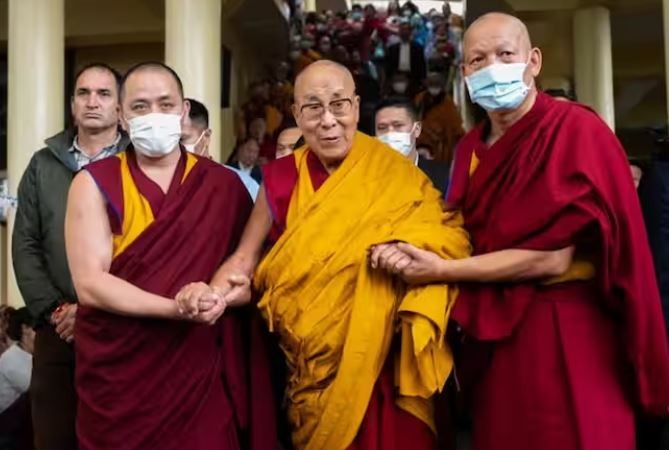
Shimla: Surrounded by the Special Frontier Force (SFF) and seated in a golf cart, the 14th Dalai Lama arrived at his residence in McLeod Ganj, Himachal Pradesh's Dharamshala, to meet with devoted followers from across the globe. The Dalai Lama, widely known for his non-violent stance against China's invasion of Tibet in 1950, remains steadfast in advocating the 'middle way' approach, which seeks autonomy within China rather than full independence.
During his interaction with a group of visiting journalists at his hilltop residence, the Dalai Lama emphasized the importance of the 'middle way' approach, which he believes can politically benefit both Tibetans and the Chinese people. He expressed optimism about the changing attitudes within China, where a considerable number of people hold him in high regard and desire his return.
Despite the immense devotion of his followers and their chants of Buddhist prayers echoing through the Himalayan landscape, the Dalai Lama stressed the use of rational and scientific thinking in advancing his cause, rather than relying solely on faith. The spiritual leader also underscored his deep connection to India, where he acquired knowledge about Buddhism from the prestigious Nalanda University. He explained his preference for Dharamshala over Lhasa, citing the region's suitability for his well-being.
The Dalai Lama's journey began in 1950 when China's invasion of Tibet initiated a series of events. He engaged with top Chinese leaders, including Mao Zedong, Deng Xiaoping, and Chou Enlai, before seeking refuge in India in 1959, where he established a Tibetan government-in-exile.
The Dalai Lama's presence in India has been a contentious issue in India-China relations. Despite strained ties between the two nations, Prime Minister Narendra Modi extended birthday wishes to the Dalai Lama in July, continuing a practice that began in 2021. Tensions between India and China have escalated since the Galwan clash in June 2020, compounded by an ongoing standoff at the Line of Actual Control in eastern Ladakh.
China has declared its intent to select a new Dalai Lama for Tibet, one who aligns with Beijing's objectives and acknowledges the rule of the Chinese Communist Party (CCP). In contrast, the Dalai Lama has outlined his succession plan, which involves consulting Tibetan religious leaders and the Tibetan people when he reaches the age of 90. He has also questioned the relevance of the traditional Dalai Lama institution in contemporary times. In summary, the Dalai Lama's advocacy of the 'middle way' approach for Tibet, his strong bond with India, and the evolving dynamics in India-China relations continue to shape discussions about Tibet's future and the legacy of the Dalai Lama.
Supreme Court Steps In: Protecting Ancient Temple Traditions in Tamil Nadu
Hindu Priests Protest Against Hate Speeches on Sanatan Dharma by INDIA Alliance Leaders